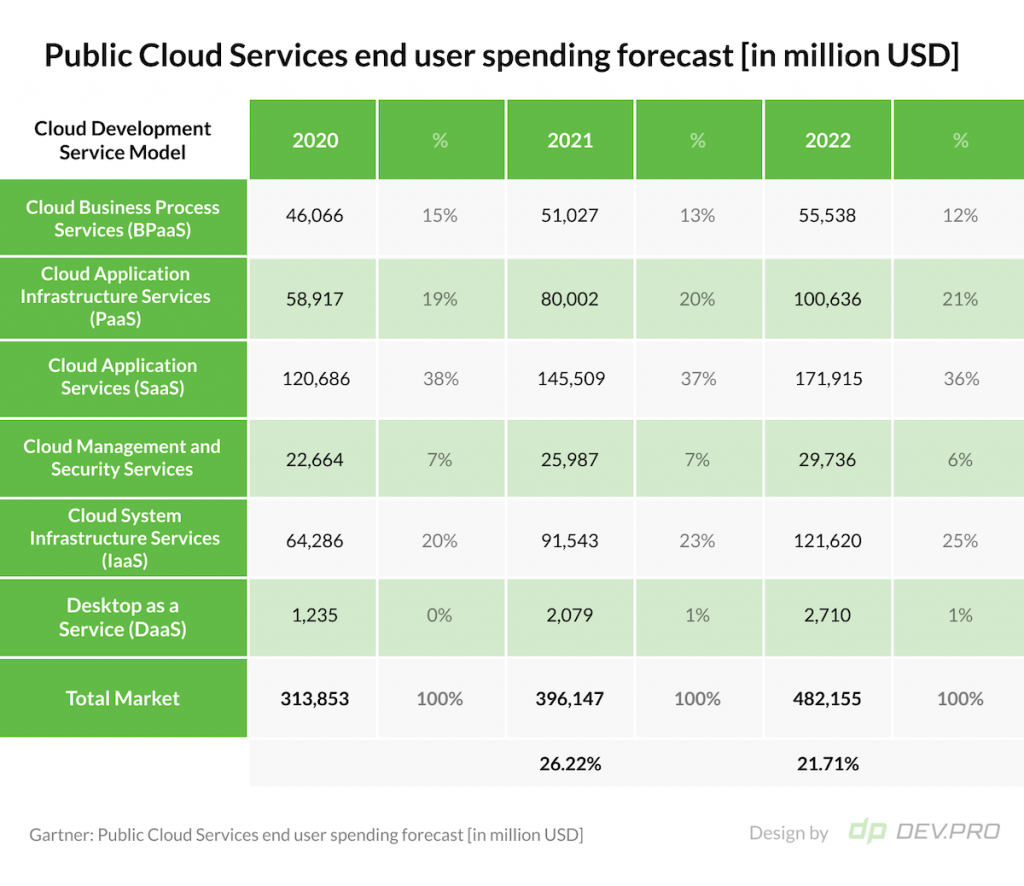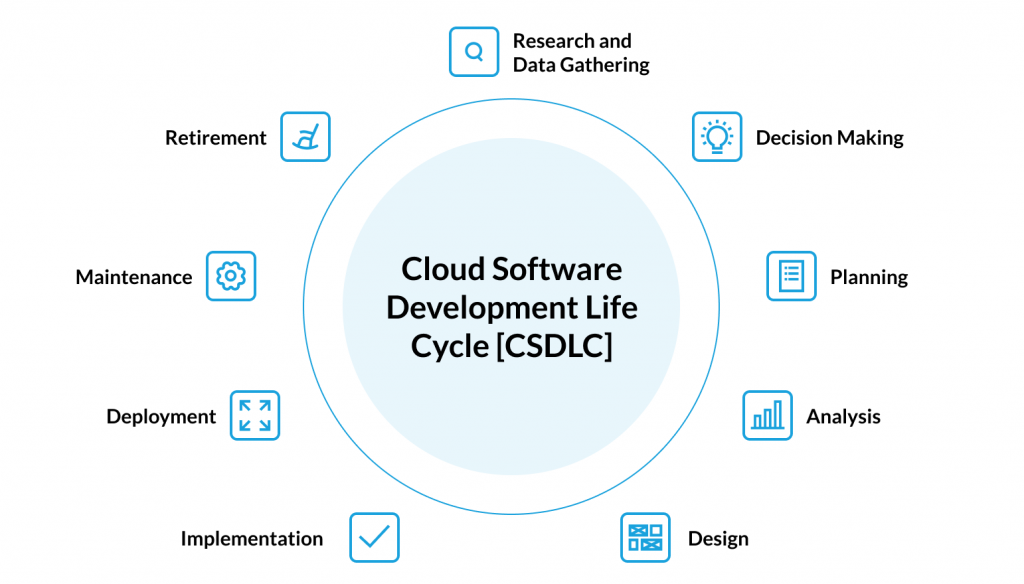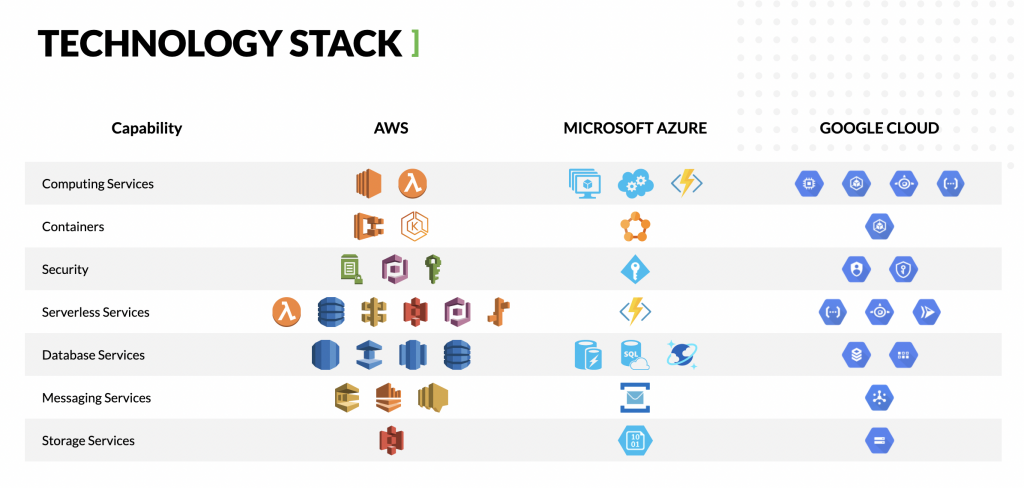Cloud software development is not yet the only way to create software products, but the word “yet” is key in this sentence.
Yep, the cloud is overtaking on-prem deployment:
- Gartner predicts that public cloud services end-user spending will grow to $482 billion by 2022 [an increase of 21.7% from 2021].
- Cloud computing is in its mass adoption stage. According to a survey by O’Reilly, 90% of organizations use it to some extent.
- Nearly a half [47%] of respondents to TKTK’s The Cloud in 2021: Adoption Continues survey say their organizations have a cloud-first approach and consider the cloud environment to be their main priority.
It’s safe to say that cloud development is the new norm. Let’s find out how your company can benefit from the technology, what pitfalls to look out for, and which best practices can help you drive ROI from cloud adoption.

The ABC of Cloud Software Development
What Is Cloud Development?
There exist different definitions of cloud development and we will use its most general interpretation for this article:
Cloud Development is the process of creating software solutions with the help of cloud compute capacity as opposed to on-prem servers. In this broadest context, we include development, deployment, and storage of any type of software products on cloud hosting or with the help of other cloud services, including web applications, mobile applications, databases.
Cloud-native software development is an approach to product development that is characterized by using cloud environments from the earliest stages of the SDLC cycle, from planning, designing, coding, building, to deploying, running, and monitoring. This approach takes advantage of the benefits inherent to cloud technology, including agility, scalability, cost-efficiency, and security. Kubernetes, Docker, APIs, and Kafka tools are often chosen to facilitate a cloud-native development framework.
With theory covered, let’s get down to practice: how do you kick off the cloud-based software development process?
Cloud-Based Development: What to Start With?
Choose the Deployment Model
Three major cloud deployment models are used by organizations, with different levels of security and cost ratios.
- Private [the most expensive of the three types, a private cloud also offers the most secure environment, so it is often used to process and store confidential data]
- Public [the cheapest deployment, it is usually used for non-critical data processing and storage]
- Hybrid [a combination of public and private: it allows you to scale the workload at sensible rates with secured private data]
Depending on the size and maturity of your company, budgets available, and sensitivity of your data, you should choose the optimal deployment model for your case.
Decide on the Service Model
The three service models delineate how much of the workload and responsibility lies on the cloud service provider and how much is left for the client.
IaaS [Infrastructure as a Service] – the cloud service provider offers storage and Virtual Machines only — a basic infrastructure.
PaaS [Platform as a Service] – on top of networking, storage, servers and virtualization included in the IaaS, PaaS also includes extended os, middleware and runtime.
SaaS [Software as a Service] – All of the hardware and software elements are taken care of by a vendor, including the data and application itself.
This decision is based on many factors, and some of these are deduced by answering these questions:
- How much technical talent do you have to config, maintain and monitor hardware and software?
- How much upfront cost are you happy to face or are you on a low-budget, pay-as-you-go mentality?
- Do you have sufficient confidence, market knowledge, and funding to see this project to the end, or is it just an experiment?
Now you are ready for the next big decision: the battle of the titans.
Select a Cloud Service Provider(s)
Amazon Web Services vs Google Cloud Platform vs Azure is a tough but critical decision to take. We recommend getting a sense of FinOps fundamentals before you go down this path.
Consider these factors before arriving at a verdict:
- Where are you and your clients based? China? Alibaba may be the answer? America? You are spoiled for choice, but some states may get better rates than others depending on your proximity to data centers.
- What does your competition and industry leaders use? Why? Check the use cases for specific economic segments.
- Is your workload predictable and how far if so? A year out? Three years out?
- Do you have Google-certified engineers onboard or Amazon-certified talent?
- Do you have infrastructure already in use that is supplied by one of the shortlisted providers?
Create or Outsource a Software Development Team
With all executive decisions out of the way, it’s time to decide on the team. professional enough to execute your software development project. If you have enough technical expertise on your existing team, great! If not, your CTO will have to suggest the optimal way of moving forward: hire more talent or outsource the cloud software development project.
Should you want to cut your time-to-market without breaking your budget, this guide on how to select a development vendor will come handy.
Once these major choices are made, it’s time to kick off your SDLC [Software Development Life Cycle].
Cloud Software Development Life Cycle [CSDLC or CDLC]
The cloud Software Development Life Cycle echoes the regular on-site SDLC, albeit with some changes arising from multiple benefits of the microservice architecture and CI/CD, which is characteristic of cloud computing [speed, agility, resilience, scalability].
These are the main phases:
Research and Data Gathering
Business requirements and cloud service suppliers are analyzed.
Decision Making
What service, and deployment model to use, which vendor and tools to choose.
Planning
Team and project planning with plenty deliverables, including development roadmap, config management and QA plan.
Analysis
System components are defined and a front-page architecture draft is considered. The initial process assignment and task distribution between teams takes place.
Design
Granular architecture is created based on requirements and resources available.
Implementation
Coding stage and commencement of testing phase.
Deployment
Deploying and gathering of feedback is a continuous process
Maintenance
Bug fixing and code improvement based on attained comments from end users, testers and developers
Retirement
Some system elements may grow redundant and are retired with consecutive fine-tuning of the remainings components
Ideally such a cloud software development life cycle will be looped as part of the CI/CD process for frequent releases, higer code quality and quicker time-to-market. A plethora of tools can help process from one stage to the next one seamlessly. These are the major tools from the arsenal of cloud engineers and architects.

Cloud Software Development Tools
There are two major alternatives to developing on cloud:
- Cloud-first approach [The less popular approach. It involves creating the cloud platform first and then building tools to run on top of it]
- Tool-first approach to PaaS [The hostable development platform is created first and pushed to the cloud after]
Multiple approaches to system architecture and proliferation of software solutions and platforms for development ensure a wide range of tools is available: cloud services by both major vendors and third parties.
GCP, for example, has CloudCode, Cloud SDK and Spring Framework tools to facilitate the coding process, Cloud Build and Jenkins on Google Cloud is used for building, while Google Cloud Deploy and Cloud Deployment Manager is used for the deployment phase. AWS has the most extensive arsenal of tools and Azure also boasts an ample assortment.
Third-party independent or open-source players also contribute to a cloud engineer’s technology stack. For example, Kubernetes and Docker are indispensable for an army of cloud professionals.

Best Practices for Cloud Software Development
Planning, UI/UX as a Firm Foundation of a Solid Product
Lincoln once said: “If I had six hours to chop down a tree, I would spend four hours sharpening my axe”.
This is true in cloud software development, as poor architecture leads to wasted resources and fixing an error early is way cheaper than correcting it after deployment. Likewise, good UX design is capable of boosting traction and securing the next round of investment.
Vendor Selection: Any System is as Good as its Weakest Link
There are two major vendors a tech company may need to procure to develop a software product in the cloud:
- Cloud service and tools suppliers
- Cloud software engineering company
While tool selection is defined by the existing infrastructure, talent, and budgets, an outsourcing partner needs to go through a meticulous selection process. Here’s our tips on how to hire a remote IT team.
DevOps: CI/CD as the Catalizer and Stabilizer
A CI/CD framework is nearly indispensable for a microservices architecture.
Automating testing processes and integrating them as early as possible into the SDLC can ensure a fast, uninterrupted release of new features and makes the entire process more predictable and stable.
Cost Optimization
FinOps culture adoption is becoming the best practice for everything cloud.
A well selected cloud service provider, choice of instance type, and knowledge of other right-sizing and right-costing methods let companies embed their Cloud Cost Optimization strategy into the company’s organizational fabric and tame bills sustainably.
Takeaways
Having a multi-cloud and a multi-vendor cloud infrastructure is more of a norm than an exception in 2022.
Cloud software development is being propelled by market consolidation, mature vendor management instruments, the proliferation of containerization, and growth of open-source technologies. Big Data, AI, IoT, ML also contribute to the exponential surge in the evolution of the cloud.
Whatever stage of cloud adoption your company is at, DevPro has the experience and resources to help you quickly migrate from on-prem to cloud or scale your existing resources to fit your business requirements. Reach out to the sales department to see our cloud tech use cases.


